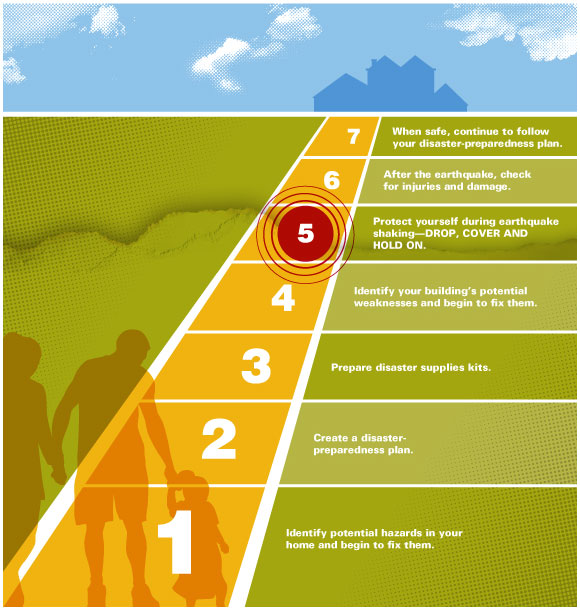A few basic tips to help you protect yourself, your family, and your property in the event of an earthquake:
Before:
- First and foremost, build an emergency kit and develop a family plan.
- Make sure shelves and other heavy items like mirrors and pictures are securely fastened to walls. Also, don’t forget to brace your light fixtures!
- Secure your water heater, refrigerator, furnace and gas appliances with wall studs and floor bolts. You may also want to consider installing an automatic gas shut-off valve that is triggered by strong vibrations.
- Place large or heavy objects on lower shelves. Store breakable items such as bottled foods, glass, and china in low, closed cabinets with latches, as well as weed killers, pesticides, and other flammable products.
- Install flexible pipe fittings to avoid gas or water leaks. Flexible fittings are more resistant to breakage.
- Identify safe spots in each room like under a sturdy table or against an inside wall.
During:
If Indoors
- Drop to the ground; take cover by getting under a sturdy table or desk; and hold on until the shaking stops. (If there isn’t something near you to take cover under, cover your face and head with your arms and crouch in an inside corner of the building.)
- Stay away from glass, windows, outside doors and walls, and anything that could fall, such as light fixtures or furniture.
- Avoid using a doorway unless you are certain it’s a strongly supported, load-bearing doorway and it’s close to you. It’s important many inside doorways are lightly constructed and do not offer protection.
- If you are in bed when the earthquake hits, stay there, hold on, and cover your head with a pillow. (If there are any heavy items near you that could fall, move to the nearest safe location.)
- Stay inside until the shaken stops and do not use an elevator.
If Outdoors
- Stay there. If you can, move to a wide open space away from buildings, streetlights, utility wires, and large trees. Most injuries occur as a result of falling debris.
If in a Moving Vehicle
- Try to stop as swiftly and as safely as possible.
- Stay in your car.
- Once the shaking has subsided, avoid roads and bridges that may have been damaged.
If Trapped Under Debris
- Do not move around or kick up dust.
- Cover your mouth with a piece of clothing and avoid yelling. You may inhale dangerous amounts of dust.
- Tap on a wall or pipe so rescuers can locate you. Shouting should only be a last resort.
After:
- Once the shaking has stopped, exit the building. Expect aftershocks. They won’t be as violent as the initial tremors, but they can still cause damage.
- Help injured or trapped persons.
- Look for and extinguish small fires.
- Listen to a battery-powered radio or television for the latest emergency information.
- Use telephones only in case of emergencies.
- After it is safe to return, inspect your home.
- Open cabinets cautiously. Beware of items that may fall.
- Inspect your chimney for damage.
- Clean up medicines, gasoline, and other flammable materials immediately
- Inspect utilities: Keep an eye out for electrical damage, gas leaks, and sewage and water line damage.
For the full guide to preparing for an earthquake, check out the FEMA page.
Click here for more information on George Mason’s earthquake preparation plan.
Click here to sign up for George Mason’s Alert system .





Leave a Reply